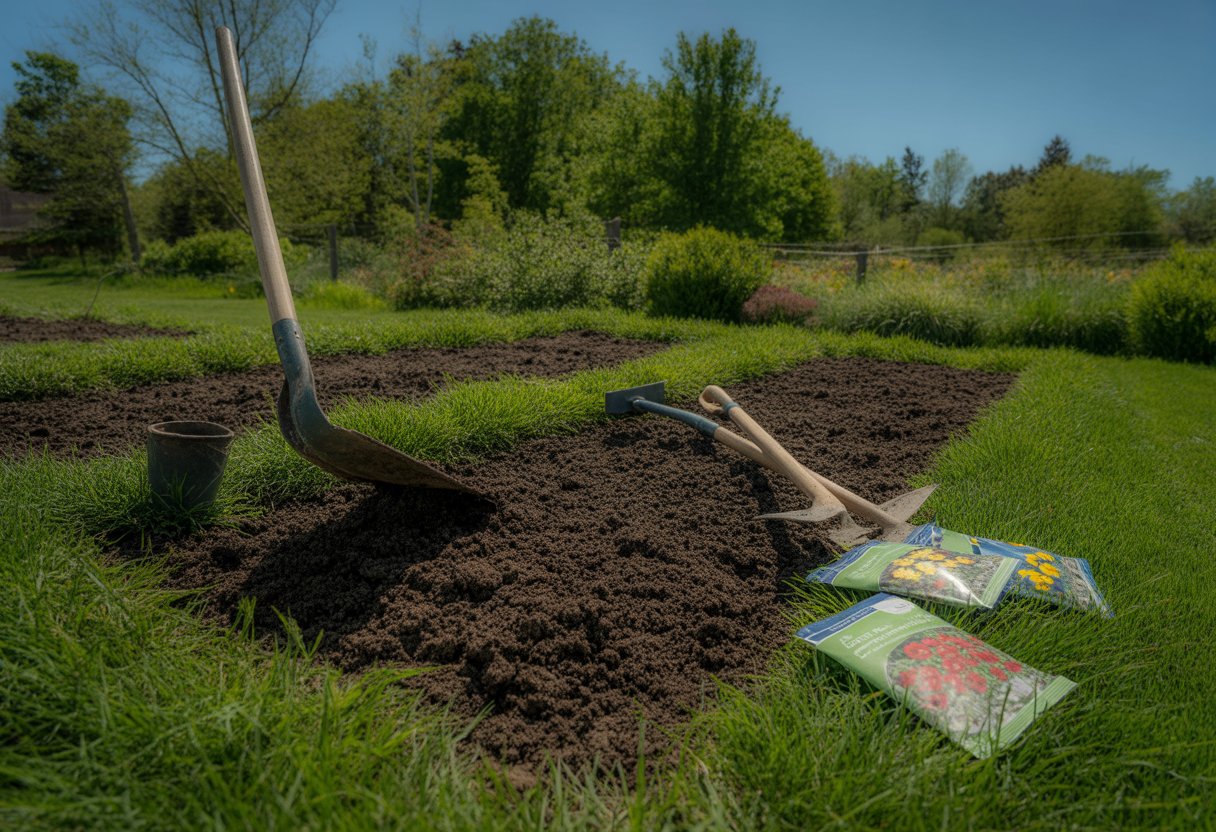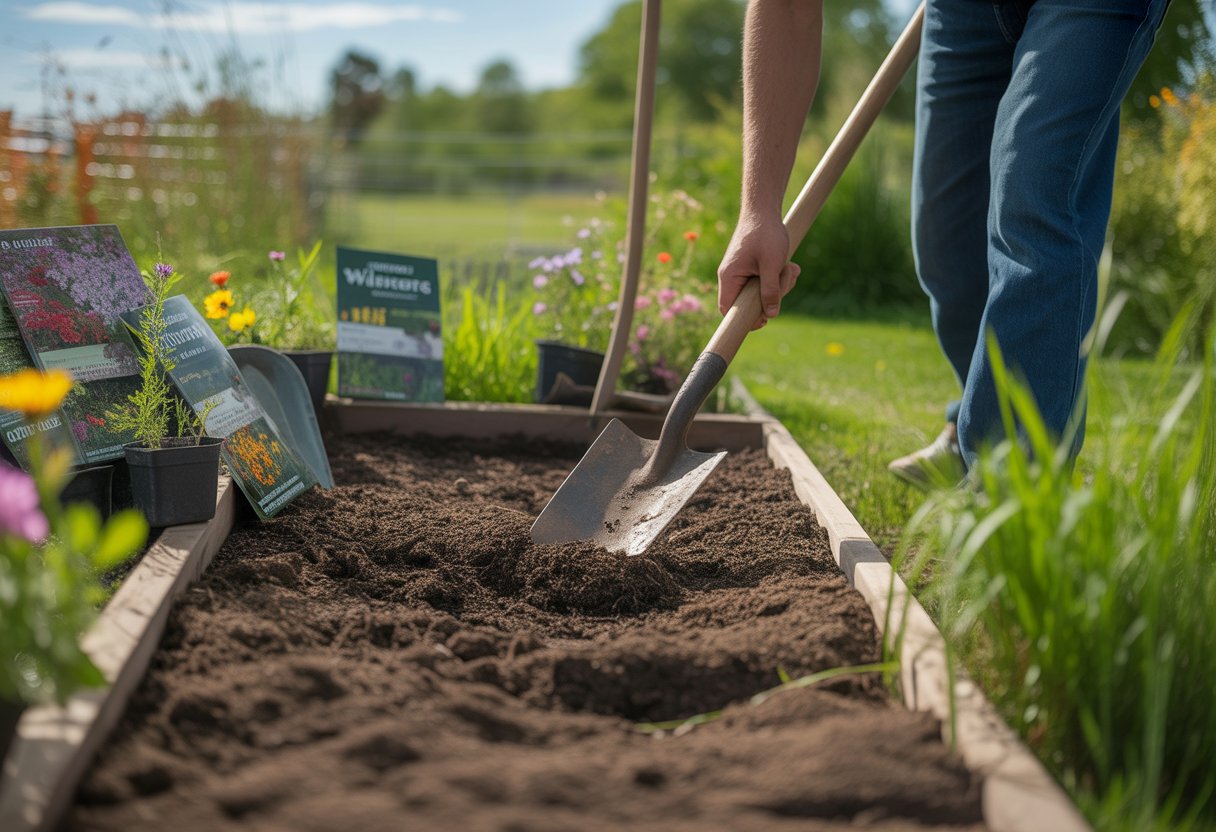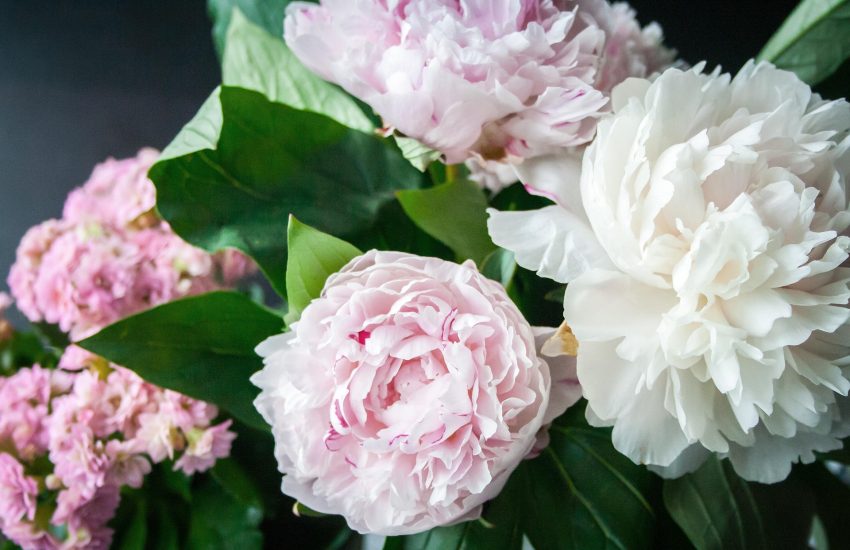Preparing Beds for Wildflowers: Essential Steps for Healthy Growth and Vibrant Blooms
Getting beds ready for wildflowers matters if you want healthy plants and big, colorful blooms. The trick is to create well-drained, nutrient-poor soil that feels like the wild places where these flowers naturally grow.
Pulling weeds and loosening up the soil lets wildflower seeds put down strong roots. Fewer weeds means less competition right from the start.

If you use native plants in your mix, they’re more likely to settle in and stick around for years. Wildflower mixes usually have lots of different species, so if you prep the bed well, you’ll get a longer, more colorful show as the seasons change.
Picking the right spot and prepping the soil doesn’t have to be complicated, but it can make a real difference for your wildflower garden.
Assessing and Selecting the Planting Site

Choosing a good spot for wildflowers comes down to soil quality, sunlight, and local climate. Each of these factors shapes how your seeds sprout and grow.
It’s worth taking a little time to check out your site before you start. Site evaluation really pays off.
Understanding Soil Types and Drainage
Soil type changes how much water and nutrients your wildflowers get. Sandy soils drain fast but don’t hold onto much food for plants.
Clay soil holds water, sometimes too much, which can rot roots if you’re not careful. Loam is the sweet spot—moist but not soggy, fertile but not over-the-top.
If you’ve got drainage issues, try mixing in some organic matter or build a raised bed. That usually helps water move through instead of pooling.
Testing your soil’s pH can help you pick the right wildflowers. Most do best in neutral or slightly acidic soil (pH 6.0-7.0), but hey, there are exceptions.
Choosing a Sunny Spot for Wildflowers
Wildflowers love the sun—think at least 6 hours of direct sunlight a day. If your spot is shady, you’ll probably get fewer flowers and weaker plants.
Sunlight also dries out the soil between rain, which helps keep fungus at bay. While a few wildflowers don’t mind shade, most really want an open, bright area.
Look around for trees or buildings that might throw shade at different times. For most wildflowers, skip those shadowy spots.
Evaluating Site Climate and Microclimates
Most wildflowers do well in temperate or colder climates, especially if there are clear seasons. Hot, humid spots can stress them out.
Even in one yard, microclimates pop up—maybe a south slope gets warm early, while a north corner stays damp and cool. These differences matter.
Find areas sheltered from harsh wind or cold-air pockets. Picking a site that fits your wildflowers’ climate preferences makes life easier for both you and the plants.
Preparing the Seedbed for Wildflower Seeds
Wildflowers need a seedbed that gives seeds a fighting chance to sprout and grow. You’ll want to clear out weeds, loosen the soil, add the right stuff, and make sure seeds can touch soil directly.
Removing Existing Vegetation and Weed Control
Start by getting rid of all the existing plants, especially tough grasses and weeds. If you skip this, wildflowers will struggle to compete.
You can smother weeds with tarps or plastic if you don’t want to use chemicals. If you go for herbicides, glyphosate works, but be careful and give it time before planting.
Pull out or kill everything so it doesn’t just grow back. Some stubborn weeds might need a few rounds of removal.
Tilling and Cultivating Soil
Tilling helps break up hard soil and lets roots breathe. Usually, turning the soil 2 to 4 inches deep does the trick.
If you’re dealing with clay, till when the soil’s moist but not soggy to avoid making a mess. Don’t overdo it, though—too much tilling can mess up the soil.
Break up big clumps and pick out rocks or debris. You want a loose, crumbly surface so seedlings can get started.
Improving Soil Structure With Compost
Mix in about 1 to 2 inches of well-aged compost to boost soil texture and fertility. Compost brings in helpful microbes and just enough nutrients.
It helps sandy soil hold moisture and loosens up heavy clay. Spread it evenly and work it into the top few inches.
Skip fresh compost, since it’s high in nitrogen and can invite weeds. You’re aiming for balanced soil—good for seedlings but not for weeds.
Establishing Proper Seed-to-Soil Contact
Seeds need to touch soil to soak up moisture and sprout. After you scatter the seeds, rake lightly or use a roller to press them in.
Don’t bury seeds too deep—most need to be at or just under the surface, about ¼ inch at most. If you plant them too deep, they might not make it.
Keep the soil damp (not soaked) after sowing. Whether it’s rain or a gentle watering, moisture is key for those first few weeks.
Sowing and Caring for Wildflower Seeds
The way you sow wildflower seeds, manage soil, pick mixes, and care for seedlings all adds up to success. Each choice matters if you want strong germination and healthy flowers like poppies or cornflowers.
Best Practices for Sowing Wildflower Seeds
Sow wildflower seeds on soil that’s been tilled and doesn’t have too much organic matter. Rake the surface to get it nice and fine for good seed-to-soil contact.
Scatter seeds by hand or use a spreader—mixing them with sand helps spread them evenly. Gently press them into the soil, but don’t bury small seeds like cornflowers too deep.
Plant in spring or autumn for the best results, since that’s when the weather usually helps out. Skip the fertilizer at this stage; wildflowers are tough and often like lean soil.
Managing Soil Temperature and Moisture
Soil temperature matters a lot for germination. Aim for 50°F to 70°F (10°C to 21°C) when you sow.
If it’s too cold, seeds just sit there; too hot, and the soil dries out too fast. Keep the soil moist with light, regular watering.
Don’t drown the seeds, but don’t let them dry out either. A thin mulch can help keep moisture in and temperature steady, but let some light through.
Watch the soil closely for the first few weeks. That’s when most of the magic—or frustration—happens.
Selecting Appropriate Wildflower Seed Mixes
Pick a wildflower seed mix that matches your soil, climate, and what you want to see bloom. Good mixes have annuals, biennials, and perennials so you get flowers for longer.
Look for region-specific mixes—those usually have plants that are already adapted to your area. Avoid anything with invasive species that might take over.
If your mix has different seed sizes, sow them in a way that gives both big and small seeds a chance. It’s a bit of a balancing act.
Ensuring Germination and Early Plant Growth
Once you’ve sown the seeds, focus on helping them sprout and grow. Keep the soil moist and a bit warm—most seeds pop up in 7 to 21 days.
If things get crowded, thin out some seedlings so the rest have space and air. Go easy on fertilizer; too much just feeds weeds.
Keep an eye out for pests and more weeds. Lightly cultivating around the seedlings can help, but be gentle—they’re fragile.
Supporting Flowering and Meadow Establishment

After planting, a bit of support goes a long way. Encouraging pollinators and sticking with simple maintenance helps your wildflowers and keeps the meadow lively.
Encouraging Pollinators in Wildflower Gardens
If you want pollinators to visit, plant a variety of native wildflowers that bloom at different times. That way, bees and butterflies always have something to eat.
Skip pesticides and herbicides—they’re rough on helpful insects. Planting in sunny, sheltered spots makes it easier for pollinators to find your flowers.
Add a shallow water dish or leave a patch of ground undisturbed for nesting. Grouping flowers in clumps, not just scattering them, makes it easier for pollinators to forage and pollinate everything.
Maintaining the Wildflower Meadow Over Time
Mow or cut back wildflowers once or twice a year. This keeps woody plants and grasses from taking over the meadow.
Open areas for sunlight matter a lot for plant growth and flowering. If you leave the cut material lying around, it can boost soil fertility too much—so get rid of it quickly.
Low-nutrient soil actually gives wildflowers a better shot than aggressive grasses or invasive species. Every year, take a look at how things are going out there.
If you spot bare patches or plants that didn’t make it, overseed or replace them. Keep an eye out for pests and diseases so you can step in early and protect your flowering plants.


